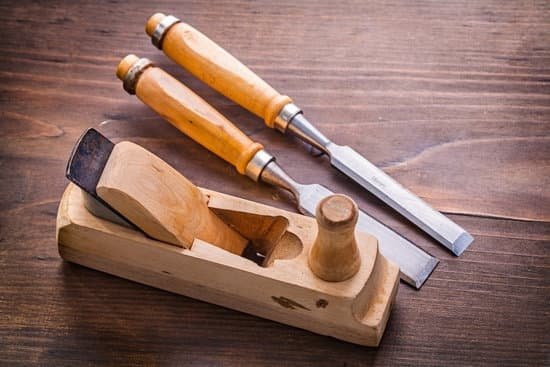Woodworking is a craft that requires precision, skill, and the right tools to bring projects to life. Aspiring woodworkers often wonder: what is the most useful woodworking tool? The answer may vary depending on the specific project or task at hand, but one thing is certain – having the right tools can make all the difference in achieving quality results.
Using the correct tools not only makes the woodworking process more efficient but also ensures the safety of the craftsman. Whether you are a beginner looking to start your woodworking journey or an experienced woodworker tackling advanced projects, having a reliable set of tools is essential. From measuring and cutting to shaping and finishing, each tool plays a crucial role in bringing your vision to reality.
In this article, we will explore the importance of using the right tools in woodworking. We will discuss basic tools every woodworker should have, evaluate the pros and cons of power tools versus traditional hand tools, introduce specialized tools for more complex projects, emphasize safety precautions when working with woodworking tools, provide tips for maintaining and storing your tools properly, suggest budget-friendly options, and highlight key points for woodworking success.
So grab your favorite tool belt and let’s dive into the world of woodworking together.
Essential Tools for Beginners
Woodworking is an enjoyable and rewarding hobby, but having the right tools is essential for success. For beginners looking to start their woodworking journey, there are a few basic tools that every woodworker should have in their arsenal. These tools not only make tasks easier but also help create precise and professional-looking woodworking projects.
Here are some essential tools for beginners:
- Measuring Tape: Accurate measurements are crucial in woodworking to ensure that pieces fit together correctly.
- Hammer: A must-have tool for driving nails and making adjustments to wooden pieces.
- Saw: Whether it’s a handsaw or a power saw, having a reliable saw is essential for cutting wood to size.
- Screwdriver Set: Make sure to have various sizes of both flathead and Phillips head screwdrivers for assembling projects.
For beginners just starting out, investing in quality versions of these basic tools will set a strong foundation for developing woodworking skills. It’s important to remember that the most useful woodworking tool is one that you feel comfortable using and helps you achieve your desired results.
Power Tools vs Hand Tools
When it comes to woodworking, one of the most common questions that arises is: what is the most useful woodworking tool? While personal preference plays a significant role in determining the answer to this question, the debate between power tools versus hand tools is always at the forefront of discussions among woodworkers. Both types of tools have their own advantages and disadvantages, making it essential for craftsmen to understand when and where to use them.
Pros and Cons of Power Tools
Power tools provide efficiency and precision when it comes to cutting, shaping, and finishing wood. Their ability to perform repetitive tasks quickly makes them ideal for large-scale projects or production work. Additionally, power tools like electric saws, drills, and sanders are often easier to use for beginners due to their user-friendly features.
However, one downside of power tools is their cost – they tend to be more expensive than traditional hand tools. They also require electricity or battery power, which can limit portability in certain situations.
Pros and Cons of Hand Tools
On the other hand, traditional hand tools offer woodworkers a sense of craftsmanship and control that power tools may lack. Hand planes, chisels, and hand saws allow for intricate detailing and fine tuning that can be difficult to achieve with power equipment. Hand tools are also quieter than their electric counterparts, making them suitable for working in residential areas or shared workspaces.
However, using hand tools requires a certain level of skill and practice to master techniques such as sharpening blades or adjusting angles accurately. Additionally, working with hand tools can be physically demanding and time-consuming compared to power tools.
Specialized Tools for Advanced Projects
When advancing in your woodworking skills and tackling more complex projects, having the right tools can make all the difference in achieving precision and efficiency. While basic tools are essential for any woodworker, specialized tools geared towards advanced projects can take your craftsmanship to the next level. Here are some key specialized tools that are essential for more complex woodworking projects:
- Router Table: A router table is a versatile tool that allows woodworkers to create intricate designs, edges, and joints with precision. It provides stability and control when routing edges or shaping profiles on wood pieces.
- Dovetail Jig: Creating dovetail joints by hand requires skill and precision, but a dovetail jig simplifies the process and ensures consistent results. This tool is indispensable for advanced woodworking projects that involve furniture making or decorative joinery.
- Thickness Planer: When working with rough lumber or need precise thickness for your project, a thickness planer is invaluable. It allows you to achieve uniform thickness across boards, ensuring seamless assembly and professional-looking results.
In addition to these specialized tools, other equipment such as a scroll saw, bandsaw, or spindle sander can also be beneficial for advanced woodworking projects. These tools offer specific functions that cater to different cutting, shaping, and finishing needs, allowing woodworkers to expand their creative possibilities. As you progress in your woodworking journey and take on more challenging projects, investing in these specialized tools can enhance your capabilities and bring your creations to life with finesse.
Remember that while having the right tools is crucial for advanced woodworking projects, it’s equally important to master proper techniques and safety precautions when using them. Always prioritize safety gear such as goggles, ear protection, and dust masks when operating power tools or handling sharp cutting instruments. By combining the right tools with skillful craftsmanship and safety practices, you can elevate your woodworking skills and achieve impressive results in your advanced projects.
Safety Precautions
Woodworking, like any other craft, can be a fulfilling and rewarding hobby. However, it also comes with its own set of risks, primarily due to the tools involved. Ensuring safety should always be a top priority when engaging in woodworking projects. This section will highlight the importance of following safety precautions and guidelines to prevent accidents or injuries.
Wearing Safety Gear
One of the most crucial safety precautions when using woodworking tools is wearing appropriate safety gear. This includes items such as safety goggles to protect your eyes from flying wood chips or debris, ear protection to guard against loud noises from power tools, and gloves to prevent cuts or splinters. Additionally, a dust mask can help protect your lungs from inhaling sawdust particles that may pose health risks over time.
Proper Tool Usage
Another key aspect of staying safe while working with woodworking tools is knowing how to use them properly. Before starting any project, familiarize yourself with the tool’s instructions and functionalities. Improper usage of tools can not only lead to subpar results but also increase the risk of accidents. Always use tools for their intended purposes and avoid using damaged or faulty equipment that could potentially cause harm.
Workspace Safety
Creating a safe workspace is just as important as using the right safety gear and handling tools correctly. Ensure that your work area is well-lit and free of clutter to prevent tripping hazards. Keep sharp objects stored safely away when not in use and always unplug power tools when making adjustments or changing blades or bits. By maintaining a clean and organized workspace, you can reduce the likelihood of accidents occurring while woodworking.
By prioritizing safety precautions such as wearing appropriate safety gear, using tools correctly, and creating a safe workspace, woodworkers can enjoy their craft with peace of mind knowing they have taken necessary measures to prevent injuries. Remember, safety should never be compromised for the sake of expediency or convenience – ensuring a safe working environment is essential for successful woodworking projects in the long run.
Maintenance and Care
Woodworking tools are essential for any woodworker, but knowing how to properly maintain and store these tools is just as crucial. One of the most important aspects of woodworking tool maintenance is keeping them clean and free from debris.
After each use, it is recommended to wipe down the tools with a dry cloth to remove any sawdust or dirt that may have accumulated during use. This simple step can help prevent rust and corrosion, extending the lifespan of your tools.
Proper storage is key in maintaining the quality of woodworking tools. Storing tools in a dry environment away from moisture and humidity can prevent rust from forming on metal components. Investing in a toolbox or a designated storage cabinet can help keep your tools organized and protected when not in use. Additionally, hanging larger tools like saws or drills on pegboards not only saves space but also makes them easily accessible when needed.
Regular inspections of woodworking tools are also important to ensure that they are functioning properly. Checking for loose screws, damaged handles, or dull blades can prevent accidents and ensure that the tools perform optimally. By taking the time to maintain and store woodworking tools correctly, woodworkers can prolong their usability and efficiency, ultimately saving time and money in the long run.
| Importance of Maintenance | Proper Storage Tips |
|---|---|
| Regular maintenance prevents rust and corrosion | Store in a dry environment away from moisture |
| Inspections help avoid accidents | Invest in a toolbox or storage cabinet |
| Maintenance extends tool lifespan | Hang larger tools on pegboards for easy access |
Budget-Friendly Tools
Woodworking can be an expensive hobby or profession, especially when it comes to investing in high-quality tools. However, there are budget-friendly options available that can still deliver effective results. When considering what is the most useful woodworking tool within a constrained budget, it’s essential to prioritize versatility and durability.
One such tool that fits this criteria is a quality set of chisels. Chisels are versatile tools that can be used for a variety of woodworking tasks, from carving and shaping wood to creating intricate designs.
In addition to chisels, a quality hand plane is another essential yet affordable tool for those on a budget. Hand planes are incredibly versatile and can be used for smoothing rough surfaces, straightening edges, and creating clean surfaces for joinery. Investing in a good quality hand plane will not only save money in the long run but also provide precise results in your woodworking projects.
Another cost-effective tool that should not be overlooked is a coping saw. Coping saws are ideal for making detailed cuts and intricate shapes in wood, making them invaluable for fine woodworking tasks.
Lastly, when looking for budget-friendly woodworking tools, consider purchasing second-hand or refurbished tools from reputable sources. Many woodworking enthusiasts upgrade their tools over time, leading to the availability of quality used tools at lower prices. By doing thorough research and being patient in your search, you can acquire essential woodworking tools without breaking the bank.
| Woodworking Tool | Approximate Price Range |
|---|---|
| Chisels | $20 – $50 (for a set) |
| Hand Plane | $30 – $80 |
| Coping Saw | $10 – $30 |
Conclusion
In conclusion, choosing the right tools is crucial for woodworking success. Whether you are a beginner just starting out or an experienced woodworker tackling advanced projects, having the appropriate tools can make a significant difference in the quality of your work. While there are various tools available in the market, finding the most useful woodworking tool ultimately depends on the specific project and your personal preference.
For beginners, investing in essential tools like a hammer, tape measure, saw, and chisels is vital to kickstart your woodworking journey. These basic tools will help you develop foundational skills and build confidence as you progress to more advanced projects.
On the other hand, power tools offer efficiency and precision but may require a higher initial investment compared to traditional hand tools. It is essential to weigh the pros and cons of each type of tool based on your skill level, budget, and project requirements.
Moreover, safety should always be a top priority when working with woodworking tools. Always wear appropriate protective gear, read and follow instructions carefully, and practice proper tool handling techniques to prevent injuries. Additionally, maintenance and care of your tools are key to their longevity and performance.
Keep them clean, sharp, and properly stored to ensure they remain in good working condition for years to come. By following these guidelines and choosing the right tools for the job, you can elevate your woodworking skills and achieve success in your craft.
Frequently Asked Questions
What Is the Essential Tool for Every Woodworker?
The essential tool for every woodworker is undoubtedly the humble chisel. With its sharp blade and versatility, a chisel is crucial for tasks ranging from shaping wood to creating intricate details.
What Is the Number One Tool in Woodworking?
The number one tool in woodworking has to be the table saw. Its ability to make precise cuts quickly and easily makes it indispensable in any woodworking shop. From ripping lumber to cutting angles, the table saw is a cornerstone of woodworking.
What Is the Tool Most Used in Your Woodworking Shop?
The tool most used in my woodworking shop would have to be the power drill. Whether it’s drilling pilot holes, driving screws, or even mixing finishes, the power drill sees constant use in almost every project. Its versatility and efficiency make it a must-have in woodworking.

Hi everyone! I’m a woodworker and blogger, and this is my woodworking blog. In my blog, I share tips and tricks for woodworkers of all skill levels, as well as project ideas that you can try yourself.





